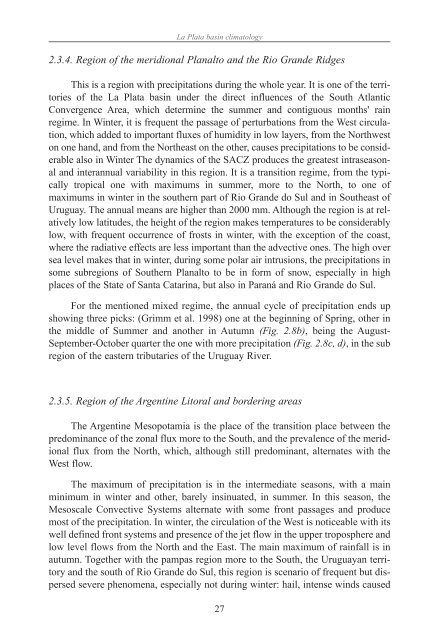chapter - Atmospheric and Oceanic Science
chapter - Atmospheric and Oceanic Science
chapter - Atmospheric and Oceanic Science
You also want an ePaper? Increase the reach of your titles
YUMPU automatically turns print PDFs into web optimized ePapers that Google loves.
La Plata basin climatology<br />
2.3.4. Region of the meridional Planalto <strong>and</strong> the Rio Gr<strong>and</strong>e Ridges<br />
This is a region with precipitations during the whole year. It is one of the territories<br />
of the La Plata basin under the direct influences of the South Atlantic<br />
Convergence Area, which determine the summer <strong>and</strong> contiguous months' rain<br />
regime. In Winter, it is frequent the passage of perturbations from the West circulation,<br />
which added to important fluxes of humidity in low layers, from the Northwest<br />
on one h<strong>and</strong>, <strong>and</strong> from the Northeast on the other, causes precipitations to be considerable<br />
also in Winter The dynamics of the SACZ produces the greatest intraseasonal<br />
<strong>and</strong> interannual variability in this region. It is a transition regime, from the typically<br />
tropical one with maximums in summer, more to the North, to one of<br />
maximums in winter in the southern part of Rio Gr<strong>and</strong>e do Sul <strong>and</strong> in Southeast of<br />
Uruguay. The annual means are higher than 2000 mm. Although the region is at relatively<br />
low latitudes, the height of the region makes temperatures to be considerably<br />
low, with frequent occurrence of frosts in winter, with the exception of the coast,<br />
where the radiative effects are less important than the advective ones. The high over<br />
sea level makes that in winter, during some polar air intrusions, the precipitations in<br />
some subregions of Southern Planalto to be in form of snow, especially in high<br />
places of the State of Santa Catarina, but also in Paraná <strong>and</strong> Rio Gr<strong>and</strong>e do Sul.<br />
For the mentioned mixed regime, the annual cycle of precipitation ends up<br />
showing three picks: (Grimm et al. 1998) one at the beginning of Spring, other in<br />
the middle of Summer <strong>and</strong> another in Autumn (Fig. 2.8b), being the August-<br />
September-October quarter the one with more precipitation (Fig. 2.8c, d), in the sub<br />
region of the eastern tributaries of the Uruguay River.<br />
2.3.5. Region of the Argentine Litoral <strong>and</strong> bordering areas<br />
The Argentine Mesopotamia is the place of the transition place between the<br />
predominance of the zonal flux more to the South, <strong>and</strong> the prevalence of the meridional<br />
flux from the North, which, although still predominant, alternates with the<br />
West flow.<br />
The maximum of precipitation is in the intermediate seasons, with a main<br />
minimum in winter <strong>and</strong> other, barely insinuated, in summer. In this season, the<br />
Mesoscale Convective Systems alternate with some front passages <strong>and</strong> produce<br />
most of the precipitation. In winter, the circulation of the West is noticeable with its<br />
well defined front systems <strong>and</strong> presence of the jet flow in the upper troposphere <strong>and</strong><br />
low level flows from the North <strong>and</strong> the East. The main maximum of rainfall is in<br />
autumn. Together with the pampas region more to the South, the Uruguayan territory<br />
<strong>and</strong> the south of Rio Gr<strong>and</strong>e do Sul, this region is scenario of frequent but dispersed<br />
severe phenomena, especially not during winter: hail, intense winds caused<br />
27






